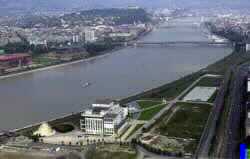HIGHLIGHTS: Leaders to Meet in Berlin to Discuss Cost of Destruction Wrought Across the Region||91 Killed, Tens of Thousands Evacuated & Many Lose their Homes||Museums & Opera Houses Forced to Close & May Need Extensive Repairs||Czech Republic Witnesses Largest Post-war Evacuation|| STORY: Record floods threatened a string of historic towns on Sunday as central European leaders were due to meet to discuss the huge costs of the path of destruction wrought across the region.
Flood waters have ravaged vast swathes of central Europe in the past week, claiming at least 91 lives in Germany, Russia, Austria and the Czech Republic.
Tens of thousands have been evacuated and many have lost their homes. Some of Europe's great museums, including Dresden's Zwinger Palace art gallery, and the city's Semper opera house have been forced to close and may need extensive repairs.
"We are going to have to live with water levels at astronomical levels for a few days more," said Georg Milbradt, premier of the state of Saxony which includes Dresden.
While officials wait for the floodwaters to fall before they can give fuller damage estimates, German Chancellor Gerhard Schroeder will meet leaders from Austria, the Czech Republic and Slovakia in Berlin on Sunday. European Commission President Romano Prodi is also expected to attend.
Britain's Financial Times said on Saturday that Prodi would promise Germany more than one billion euros (dollars) in financial assistance. Officials in Brussels and Berlin said it was too early to speculate on the amount.
French President Jacques Chirac said in a letter to Schroeder: "Germany knows it can count on France's support within European institutions in assessing aid measures for the regions hit by this tragedy."
CZECH WATERS IN RETREAT
In the Czech Republic, water levels continued to retreat on Saturday from earlier record levels, but thousands of people driven from flooded areas were still unable to return home following the country's largest post-war evacuation.
The Danube, swollen by torrential rains, rose rapidly in Budapest, but officials predicted the city's 10-meter (33-foot) high defenses would hold. Water levels have broken all records on the upper section of Europe's largest inland shipping route.
Thousands were evacuated from the industrial town of Bitterfeld in formerly communist East Germany amid fears of an environmental disaster if water from a burst dam reached nearby chemical plants. They were still dry on Sunday.
Officials said the situation was also critical in Torgau, best known as the place where U.S. and Soviet forces met on the Elbe in World War II. The water reached its highpoint there on Sunday after about 10,000 people were evacuated, and even the flood crisis command center had to move to higher ground.
In Wittenberg, the city where theologian Martin Luther nailed his 95 theses on the church doors, emergency workers were hastily building new defenses against water after one dam burst.
As in many cities on the Elbe, thousands of Dresden citizens volunteered to join 5,000 public workers to stack sandbags to against the floodwater, often mixed with sewage.
Thousands of other residents strolled and cycled along the Elbe to see the record water levels, a few even donning swimsuits for sunbathing. An organ-grinder even set up in business opposite a stack of sandbags, giving one city center square a bizarre carnival atmosphere as firemen nearby continued their clean-up efforts.
PHOTO CAPTION
Aerial view of the Danube river overflowing its lower embankments in Budapest, Hungary, Sunday Aug. 18, 2002. At least 1,700 residents had to be evacuated and some 20,000 people participate in filling sandbags to reinforce the dams along the river that already overflowed the flood area at many places in Pest county. According to meteorologists the overflowing Danube river will reach its highest point at Budapest on Sunday. (AP Photo/MTI/Sandor H. Szabo
- Author:
& News Agencies - Section:
WORLD HEADLINES


 Home
Home Discover Islam
Discover Islam Quran Recitations
Quran Recitations Lectures
Lectures
 Fatwa
Fatwa Articles
Articles Fiqh
Fiqh E-Books
E-Books Boys & Girls
Boys & Girls  Articles
Articles










